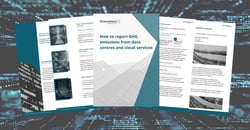How to report GHG emissions from data centres and cloud services guide
 Greenstone has published a guide on 'How to report GHG emissions from data centres and cloud services guide' designed to help sustainability and ESG professionals accurately measure and report GHG emissions from data centres and cloud services.
Greenstone has published a guide on 'How to report GHG emissions from data centres and cloud services guide' designed to help sustainability and ESG professionals accurately measure and report GHG emissions from data centres and cloud services.
The world around us is constantly evolving and we currently find ourselves in a highly digitised age of streaming services, cryptocurrencies and internet traffic. Over the past decade, energy usage in the information and communications technology (ICT) sector, including our increasing reliance on data centres, has grown exponentially.
Data centres use vast amounts of energy to function and as a result, contribute almost as much to global emissions as the airline industry (Moen, 2021). It is therefore important to understand how data centres function and what role they play as we work towards a more sustainable future.
This guide includes:
- Introduction to GHG emissions contribution from data centres
- What is a data centre/cloud service?
- What are the GHG reporting boundaries for data centres?
- Allocating and calculating GHG emissions
- Useful resources
Greenstone and GHG emissions
Greenstone enables accurate and robust GHG emissions calculation through its award-winning sustainability software and support services.
Environment module:
Greenstone’s Environment module, part of its Enterprise sustainability reporting software, automatically calculates GHG emissions associated with a variety of data sources (e.g. energy, transport, waste, water and fugitive gases) across an organisation.
This module uses Greenstone’s ever-evolving database of 1m+ emissions factors from international standards including GHG Protocol, Defra, US EPA and IEA.
SupplierPortal:
Greenstone’s supply chain software, SupplierPortal, enables organisations to distribute questionnaires and carbon ‘wizards’ to their suppliers to enable them to calculate their carbon footprint and report this data back to the buyer. This emissions data can then be automatically included in the reporting organisation’s overall scope 1, 2 and 3 footprint for management, target setting and performance tracking.
InvestorPortal module:
Greenstone’s Investor ESG software, InvestorPortal, enables investors to request and collect ESG data from funds and portfolio companies. Portfolio companies can use the GHG emissions ‘wizards’ to simply and quickly calculate their carbon footprints and report this data to their investors. This emissions data can then be used in an investor’s scope 3 footprint.











